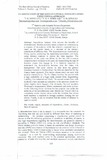Classification of the Kenyan general insurance risks using copula approach

View/
Date
2012Author
Mwalili, S. M.
Weke, P. G. O.
Mung'atu, J. K.
Type
ArticleLanguage
enMetadata
Show full item recordAbstract
Dependence between risks reduces the benefits of
diversification. Modem portfolio theory is based on correlation as
a measure of dependence while the criterion presented here is
based on the copula theory as a measure of the intrinsic
relatedness of different risks. The dependencies are examined by
fitting copulas, estimating the dependence parameters and lastly
using distance matrices to cluster the risks together. The
motivation of the study was driven by the fact that insurance
companies have collapsed in the past, one reason being the type of
business classes they engage in. It is therefore important to
understand the dependencies between risks for better risk
management. The study derives its data from the general
insurance business in Kenya where the risks are classified by the
Copula based approach. Five major classes stand out each with
peculiar characteristics. The first cluster involves the rare but with
a high probability of a huge claim amount lines: Engineering,
Liability, Fire industrial and Theft. The second contain lines with
moderate claim amounts as compared to the previous cluster but
rather slightly more frequent: Fire domestic, Personal accident,
Workman's compensation, Motor commercial and motor private.
In the following cluster we have the less popular lines under the
umbrella of the miscellaneous class. Marine and Transit which is
completely erratic clusters alone while the Aviation line whose
main business is exported to foreign countries forming the last
cluster. Finally, it can be remarked that the choice of distance to
apply is crucial.
Citation
The East African Journal of Statistics Volume 5, Number I, pp. 121-134Publisher
JKUAT Press Ltd Statistics and Actuarial Science Department Jomo Kenyatta University of Agriculture and Technology Actuarial Science & Financial Mathematics Department, School of Mathematics, University of Nairobi
